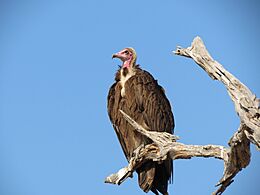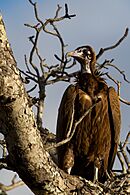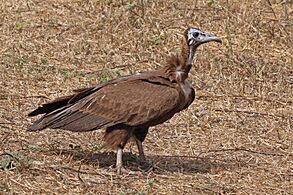Hooded vulture facts for kids
Quick facts for kids Hooded vulture |
|
|---|---|
 |
|
| in Gambia | |
| Conservation status | |
| Scientific classification | |
| Genus: |
Necrosyrtes
|
| Species: |
monachus
|
| Synonyms | |
|
Neophron monachus (Temminck, 1823) |
|
The hooded vulture (Necrosyrtes monachus) is a type of Old World vulture. These birds are related to eagles, kites, buzzards, and hawks. It is the only bird in its group, Necrosyrtes.
This vulture lives in sub-Saharan Africa. You can find it in many parts of southern, eastern, and western Africa. It looks a bit messy, with dark brown feathers. It has a long, thin beak and a bare head and neck. Its face is often a light red color.
Hooded vultures mostly eat dead animals. They also eat waste from human areas. Sadly, their numbers are dropping fast. This is due to things like poisoning, hunting, and losing their homes. Because of this, the International Union for Conservation of Nature says it is "critically endangered". This means it is at a very high risk of disappearing forever.
Contents
What's in a Name?
The name "hooded vulture" comes from its look. It has a small patch of soft feathers. These feathers run from the back of its neck to the top of its head. This makes it look like it's wearing a fluffy, cream-colored hood.
Its scientific name, Necrosyrtes monachus, has a cool meaning. "Necro" means it eats dead things. "Monachus" is Latin for "monk". This also refers to the hood-like feathers.
How They Look
The hooded vulture is a typical vulture. Its head is usually pinkish-white. But it can turn red when the bird is upset or excited. It has a grey or black "hood" of feathers. Its body feathers are mostly dark brown.
These vultures have wide wings for soaring high in the sky. They also have short tail feathers. They are among the smaller Old World vultures. They grow to be about 62 to 72 centimeters (24 to 28 inches) long. Their wingspan can be 155 to 180 centimeters (61 to 71 inches). They weigh between 1.5 and 2.6 kilograms (3.3 to 5.7 pounds).
Both male and female vultures look similar. Young vultures look like adults. But they are darker and plainer. Their body feathers might have a purplish shine.
Their Voice
Hooded vultures are usually quiet birds. But they make a sharp, hissing whistle when mating. They also make thin squealing calls near their nests or when eating.
Where They Live
Hooded vultures live across a wide area of Africa. You can find them in countries like Senegal, Mauritania, and Nigeria in West Africa. In East Africa, they live in Chad, Sudan, and Ethiopia. They are also found in southern Africa, in places like Namibia and South Africa.
Even though they are found in many places, their populations are not always strong. Some areas have very few of them left.
What They Eat and Do
Like other vultures, hooded vultures are scavengers. This means they mostly eat dead animals. They find food by flying high over savannas. They also look for food near human homes, like at waste dumps. They can also eat insects. Sometimes, many vultures gather when lots of insects appear.
These vultures are not picky eaters. They are very good at finding food. They often live near people in West Africa. In West Africa, they often fly in large groups. You might see 50 to 250 vultures together. This is especially true when they are looking for food at places where animals are processed. In southern Africa, they are more often seen alone. They are known to follow other animals that scavenge, like African wild dogs and hyaenas.
Hooded vultures are usually not afraid of humans. They often gather around towns and villages. Some local people even call them the "garbage collectors." In some universities in Ghana, more hooded vultures live near student housing. Their numbers increase when school is in session.
These vultures are most active during the day. During the dry breeding season, they stay closer to their nests. They need to return often to care for their eggs and young. Breeding happens in the dry summer season in both the northern and southern parts of their range.
They like to build nests in trees with lots of leaves. These trees are often found along rivers. The nest is usually high up in a tree fork, about 15 meters (50 feet) off the ground. But they can also be found in many different types of places. This includes open grasslands, deserts, and forest edges. They tend to live in larger numbers where bigger vultures are not common. They can live up to 4,000 meters (13,000 feet) high. But they are most common below 1,800 meters (5,900 feet).
Reproduction and Life Cycle
Hooded vultures lay one egg at a time. The egg hatches after about 46 to 54 days. The young bird stays in the nest for 80 to 130 days. After leaving the nest, the young vulture still depends on its parents for another 3 to 4 months. Studies in South Africa show that many pairs successfully raise young each year.
Population Changes
The number of hooded vultures is stable in Gambia. But almost everywhere else, their numbers are falling fast. On average, their population has dropped by 83% over the last 53 years. The total number of these vultures is thought to be around 197,000 birds. Some areas have seen very quick declines. This is similar to what happened to vultures in Asia in the 1990s. The highest number of hooded vultures can be found in western Gambia.
Threats to Hooded Vultures
The hooded vulture is now listed as "critically endangered." This is because its population is dropping very quickly. Many things cause this decline.
One major threat is poisoning. This can happen by accident. For example, if other animals are poisoned and the vultures eat them. It can also be on purpose. Sometimes, people who hunt illegally poison animals. They do this to keep vultures from circling above. Vultures circling can alert park rangers to illegal hunting. In 2019, over 500 vultures of different types, including hooded vultures, died in Botswana. This happened after they ate elephants that were poisoned by illegal hunters.
Hunting is another big problem. Vultures are hunted for different reasons. In some cultures, people believe that parts of the vulture can help with certain things. They are used in traditional practices. Vultures are also sometimes used as food. In Nigeria, researchers found that many traders were selling vulture parts. Most of these were hooded vultures. About 40% of traders sold them for spiritual healing. About 25% sold them for people to eat.
Some people believe vulture body parts can help with illnesses. They also think it can bring good luck in gambling or business. Some even think it can make children smarter.
Another threat is bird flu (H5N1). Hooded vultures can get sick and die from this. They likely catch it from eating dead chickens that were thrown away. Also, fewer tall trees are available for them to build nests. This is another reason for their decline.
Helping Hooded Vultures
Many countries in Africa protect birds of prey, including the hooded vulture. This is part of an international agreement. There are plans to watch and protect African birds of prey. Some hooded vultures live in protected areas.
Experts suggest that governments need to control pesticides and poisons. This is the best way to slow down the decline of vultures in Africa. In the 1990s, many vultures in Asia died. This was because of a medicine used for livestock. Vultures ate the dead animals and got poisoned. By controlling harmful chemicals, we can help prevent a similar disaster for African vultures.
Gallery
-
Adult in Moremi G.R., Botswana
-
Juvenile in Sabi Sand G.R., South Africa
-
Juvenile in The Gambia








